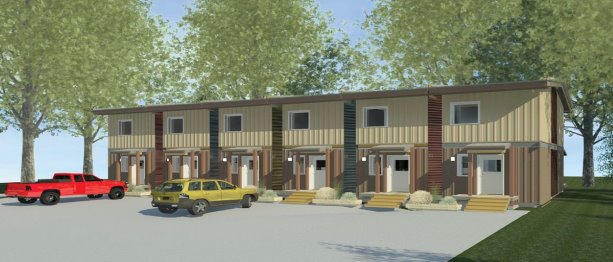Like most parts of Canada, Yale First Nation (YFN) in British Columbia gets cold in the winter and it has the high heating bills to prove it.
To put a lid on the amount that families were paying to heat their houses, YFN decided to build new rental housing.
To that end, it engaged Britco Construction, a modular building company, to build 10 two-bedroom units.
Not only are the homes cheaper to heat, they also meet the high energy-efficiency standards of Passive House (PH), a voluntary standard for reducing a building’s ecological footprint.
To tell attendees of Buildex Calgary 2017 the story of how a housing problem was turned into a solution, Craig Mitchell, Britco director of innovative solutions, and Crystal Sedore, YFN housing manager, will present T09 — An Affordable Reality: Bringing Passive House to Yale First Nation on Thursday, Nov. 9.
The presenters will discuss what the PH design entails, how YFN made the project an affordable reality, and the community’s plans to track the energy use of the two complexes.
YFN, located 153 kilometres east of Vancouver, has about 100 members living on three neighbouring reserves.
"We had a serious crisis on our hands," said Sedore. "There wasn’t enough up-to-date housing that was suitable for our members. The reserve was over-housed and what housing we had was old and unhealthy."
Most of YFN’s rental housing was three-bedroom, ranch-style, single-detached houses.
"But our population has been aging and dwindling, with younger members moving to larger centres in the Fraser Valley or Vancouver," she said. "We didn’t need big houses anymore."
In addition, the old structures were expensive to heat. In the winter, which can be cold in the eastern Fraser Valley, some families were spending over $200 per month to keep warm.
"Many families were closing off some of the rooms in their houses, and heating only the ones they used," said Sedore. "That led to mold and rodent infestation, which resulted in further deterioration of the houses."
Because single-family houses, even small ones, were outside the budget of YFN, it opted for modular housing with simple features that are easy to clean and maintain.
"We decided to engage Britco, since we knew it had built Canada’s first multi-unit modular Passive House in Bella Bella [BC] in 2015," said Sedore.
Britco completed a six-plex, consisting of 12 modular units in May 2017 and a four-plex (eight modules) in October 2017.
"We’re very satisfied with them," she said. "They’re air-tight and aligned in such a way to keep heating and cooling bills down."
The members like the new units, too. Since the housing was built, 40 band members who had been living outside the reserve have decided to move back.
"We plan to build two new large duplexes that will be suitable for larger, multi-generational families," said Sedore.
The units’ modularity is what make them affordable.
"It takes much less time to build them than ranch-style detached housing," said Sedore. "It took three months to build the six-plex. It would have taken a year to build six single-detached houses."
PH is a home designed to be so energy-efficient that it can stay warm at 17 degrees C with residents’ body heat, energy from the sun and turning on the lights.
PH uses strict construction standards and material specifications to minimize heat seepage.
That means thicker insulation than standard building codes require, triple-glazed insulated windows that face the sun, and a heat-recovery ventilation system (HRV) to ensure fresh air cycles through the house while maintaining internal temperatures.
Because PH has many requirements and details, it lends itself to the factory assembly of modular housing, says Britco’s Craig Mitchell.
"Building modular housing is similar to building cars on an assembly line," said Mitchell. "Unlike a building site, a factory is a clean, dry, climate-controlled environment that’s out of the rain and the elements."
Once a modular unit has been delivered, it takes little time to erect.
"It takes 30 per cent to 40 per cent less time than a structure built on-site," said Mitchell.
"On the Bella Bella project, from the time they delivered by barge until turn-over to the owner, it took 45 days to put up the units."

The Yale First Nation in British Columbia engaged Britco Construction, a modular building company, to build 10 two-bedroom units to meet the high energy-efficiency standards of Passive House. Attendees at Buildex Calgary 2017 will hear more about it during a seminar entitled An Affordable Reality: Bringing Passive House to Yale First Nation on Thursday, Nov. 9.
Photo: Britco Construction"










Recent Comments